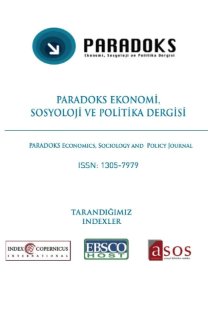TÜRKİYE’DE DIŞ BORÇLANMANIN EKONOMİK BÜYÜMEYE ETKİSİ: ARDL SINIR TESTİ YAKLAŞIMI
Gelişmekte olan ülkeler ekonomik kalkınma ve büyümelerine olumlu etkide bulunmak için dış borçlanma yoluna gidebilmektedirler. Ancak alınan dış borçlar etkili kullanılamayıp ve geri ödeme sürecinde tekrar borçlanma yoluna gidilmesi ekonomik büyümeyi olumsuz yönde etkileyebilmektedir. Çalışmada Türkiye için dış borcun ekonomik büyüme üzerindeki etkisi 1971-2011 dönemi için analiz edilmiştir. Pesaran vd. (2001) tarafından geliştirilen sınır testi yaklaşımı ile dış borcun ekonomik büyüme üzerindeki kısa ve uzun dönemli ilişkileri belirlenmiştir. Uzun dönemli analizden elde edilen bulgular, dış borcun ekonomik büyüme üzerinde negatif ve istatistiksel olarak anlamsız bir etki yarattığını ortaya koymuştur. Diğer taraftan hata düzeltme modeli sonuçları dış borcun büyümeyi negatif ve istatistiksel olarak anlamlı etkilediğini göstermiştir. Bu ampirik sonucun önemi; alınan dış borçların uzun dönemde büyümeye etki edemediğini ancak kısa dönemde ise dış borçların etkin alanlarda değerlendirilemeyip büyümeyi olumsuz yönde etkilediğini ortaya koymuş olmasıdır.
Anahtar Kelimeler:
Dış Borç, Ekonomik Büyüme, ARDL Yaklaşımı
THE IMPACT OF EXTERNAL DEBT ON ECONOMIC GROWTH IN TURKEY: AN ARDL BOUNDS TESTING APPROACH
Developing countries can choose the way of having external debt to positively affect their economic development and growth. However, not using the external debt effectively and choosing the way of having external debt during its repayment might affect the economic growth negatively. This paper attempts to analyze the effect of external debt on economic growth in Turkey, utilizing annual data for the period 1971–2011. In the paper, the existence of the long run equilibrium relationship between economic growth and external debt is investigated by applying the bounds test approach to cointegration developed by Pesaran et al. (2001). The findings obtained from long-run analysis reveal that the external debt has a negative and statistically insignificant effect on economic growth. On the other hand, the results of error correction model show that the external debt, in the short run, has a negative and statistically significant effect on economic growth. The significance of these empirical results is that the external debt did not affect the economic growth in the long run while the external debt which was not used in effective areas affected the economic growth negatively in the short run.
Keywords:
External Debt, Economic Growth, ARDL Approach,
- ISSN: 1305-7979
- Yayın Aralığı: Yılda 2 Sayı
- Başlangıç: 2005
- Yayıncı: Sema AY
Sayıdaki Diğer Makaleler
TÜRKİYE’DE DIŞ BORÇLANMANIN EKONOMİK BÜYÜMEYE ETKİSİ: ARDL SINIR TESTİ YAKLAŞIMI
Yrd.doç.dr. Murat Can GENÇ, Dilek TANDOĞAN
ULUSLARARASI SİYASAL EKONOMİNİN AKIL OYUNLARI: HEGEMONİK SİSTEM VE ULUS-DEVLET ÇATIŞMASININ GELECEĞİ
KENTLİLİK BİLİNCİ ÇALIŞMALARI İÇİN BİR MODEL ÖNERİSİ: BURSA’DA KENTLİLİK BİLİNCİ ARAŞTIRMASI
Dr. Enes Battal KESKİN, Yrd.doç.dr. Mehtap SAĞOCAK, Doç.dr. Tülin Vural ARSLAN
SATIŞÇILARIN BİLİŞSEL VE DUYUŞSAL DEĞERLENDİRMELERİNİN MESLEKİ YAŞAM MUTLULUĞU ÜZERİNDEKİ ETKİLERİ
